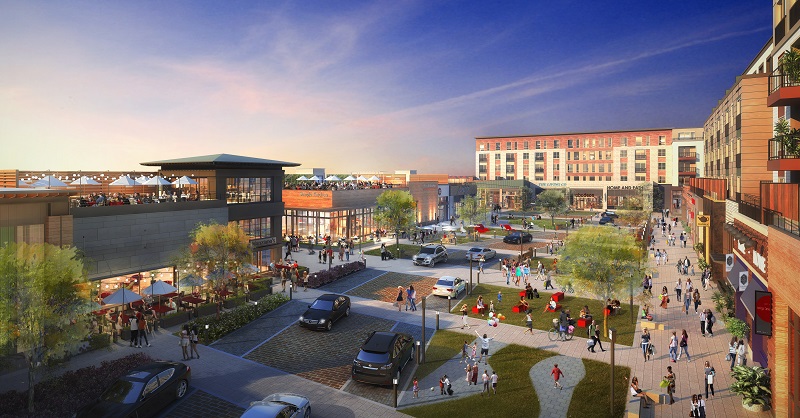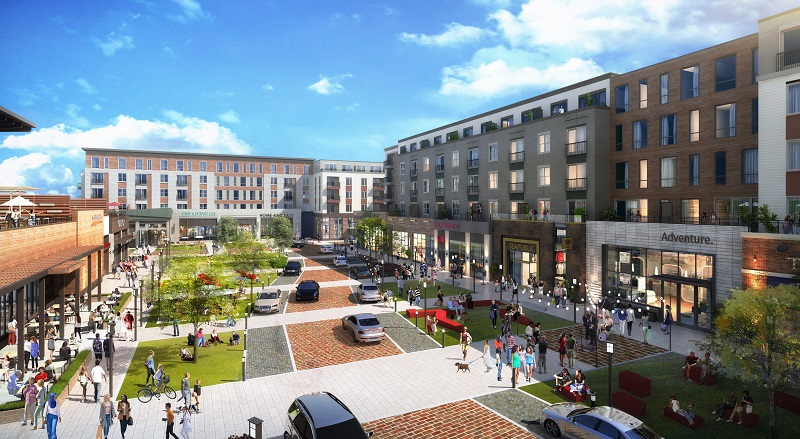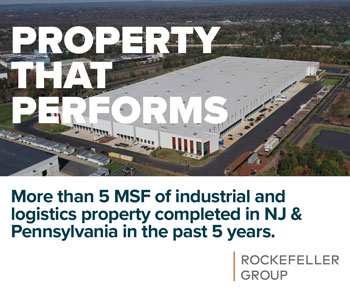Plans for The District at 1515 in Parsippany call for 100,000 square feet of retail space and 441 residential units over two phases. Stanbery Development also intends to build a hotel on an adjacent five-acre portion of the property that sits within neighboring Hanover. – Courtesy: Stanbery Development
By Joshua Burd
After more than a decade, Stanbery Development Group knew the area well.
The Bexley, Ohio-based firm made its debut in New Jersey in 2003 with the opening of The Shoppes at Union Hill, an upscale, 91,000-square-foot retail center along Route 10 in Denville. And it wasn’t long before the developer had a real-time look at the demographic power of Morris County.
It’s why Stanbery’s principals recognized the potential of a site about four miles away — the former Intel Corporate Center at 1515 Route 10 in Parsippany — when it came available in fall 2014. The functionally obsolete, 288,742-square-foot office complex also provided the redevelopment opportunity that would allow the firm to create the type of mixed-use, retail-anchored town center project that it was now looking to build.

“We knew it was a fabulous retail corridor for the type of retail we like to do and the way we like to do it,” said Mark Pottschmidt, a co-founder and partner of Stanbery. “And then this opportunity came about.”
More than four years later, the firm is on a clearer path toward fulfilling its plans for a high-end, downtown-style destination at the 17-acre site, which includes about five acres in neighboring Hanover. Known as The District at 1515, the project calls for 100,000 square feet of retail space, 441 residential units and a hotel.
Admittedly, that path has been fraught with challenges. Since it closed on the property in early 2015, Stanbery has dealt with concerns over density and affordable housing requirements, negotiations over a payment in lieu of taxes agreement and the need to navigate two municipalities.
But the firm, having cleared those hurdles, now has a more concrete timeline in place: Pottschmidt said the firm hopes to secure site plan approvals by the start of the summer, followed by demolition this fall and a groundbreaking early next year.
“We’ve had a ton of interest from great retailers and restaurants, but we have not been able to get any leases signed or letters of intent signed because we’ve never known what our delivery date is going to be for the project,” he said. “So we’re getting a lot closer to that now.”
Stanbery also hopes to launch a full-fledged marketing campaign ahead of the International Council of Shopping Centers’ annual RECon event in Las Vegas in late May. And with two liquor licenses in hand, Pottschmidt feels his team is well-equipped to attract the types of food and beverage, lifestyle and experiential tenants that will anchor the town center within the project’s first phase, which would include some 60,000 square feet of commercial space and around 275 apartments.
“We’ll be ready to really start rolling that out and getting commitments from specific retailers,” he said. “But right now, we’ve been kind of waiting in the wings for that.”

Pottschmidt recalls visiting Parsippany’s mayor at the time, James Barberio, soon after the vacant Intel complex became available in late 2014. Walking into the mayor’s office, he and Stanbery co-founder Jon Meyer recognized a familiar face — Ellen Sandman, the township’s business administrator — who had held the same position in Denville more than a decade earlier when the firm completed The Shoppes at Union Hill.
The Stanbery team took it as a good omen.
“She knew that we can deliver a great project,” Pottschmidt said. “So that helped that she knew us, we knew her and they loved the look of the project, so we went out and bought the property.”
The developer — which paid $14.1 million for the two-building complex, under a transaction by Collliers International’s Jacklene Chesler — had another reason to be bullish. Parsippany offered even more upside from what was already a strong market around its Denville project.
“We knew that was a great area, demographically, and it’s really been one of our better shopping centers,” Pottschmidt said. “We knew this had even better demographics because it’s closer to the daytime population, and we knew with the daytime population, we could attract the best in class in all restaurant categories.”
But Stanbery still faced several obstacles in Parsippany. For one thing, the firm hoped to attract an outside partner to oversee the multifamily component, Pottschmidt said, but that required it to move the project through a significant portion of the entitlement process.
The developer soon realized that, in order to attract the right types of operators — with rooftop dining and users such as spin and yoga studios — its project required a higher density for multifamily than Parsippany had ever seen before. That looked to be a heavy lift with the sprawling, suburban municipality.
“That was the first hurdle,” Pottschmidt said during a recent conference hosted by New Jersey Future, the smart growth advocacy organization. “In creating an urban node, we needed a certain density, a certain critical mass to make the retail portion really hum.”
The second hurdle? Towns such as Parsippany were under growing pressure to expand their stock of affordable housing, following a landmark ruling from the state Supreme Court in March 2015. That, however, turned out to help Stanbery move forward.
“They saw our project as an opportunity to help with their housing plan,” Pottschmidt said, so the development team and local officials began to discuss inclusionary housing as part of the plan. After a long negotiation, they agreed on a 15 percent set-aside, which will include 34 units built on the site and a $3.3 million payment to the town’s Affordable Housing Trust Fund.

The developer also navigated a change in administration in Parsippany after Barberio, a two-term incumbent, was defeated by current Mayor Michael Soriano. That extended and impacted negotiations over a payment in lieu of taxes agreement, or PILOT, that Pottschmidt said was essential to the project.
Those discussions centered on cutting the number of residential units by nearly half, to 441, along with increasing the revenue to the township to help cover the cost of new school children that result from the project. Stanbery also agreed to make a series of traffic improvements to the intersection of routes 10 and 202 during phase one of the project — rather than phase two, as it had originally planned — and by agreeing to pay prevailing wage for those upgrades.
Soriano, who also spoke during New Jersey Future’s annual Redevelopment Forum, said the township was balancing the concerns of local residents with the need to repurpose a defunct commercial property. The PILOT agreement allowed it to address both needs.
“I don’t need to explain to this room that we were losing tax revenue on this place every year,” Soriano said in early March during the program in New Brunswick. “This may have been a white elephant, but it was a dirty, beat up white elephant, so this is a better face for it.”
The financing for the project will also include $6.5 million under the state’s Redevelopment Area Bond program, which is pending approval by its would-be sponsor, the Morris County Improvement Authority.
As for the Hanover portion of the project, local officials were opposed to any residential development from the start. Stanbery has instead crafted plans for a hotel, which Pottschmidt feels will also be an important component in creating a new town center.
“We needed to head in a different direction for Hanover,” he said, “but we certainly needed them by our side to get this done as well because the jurisdiction line runs right through both towns.”
If they aren’t already, residents of Parsippany and Hanover will soon be familiar with the concept of a “woonerf,” a plaza that essentially blurs the lines of vehicular and pedestrian traffic. The Dutch-inspired concept does not use curbs but rather changes in pavement, bollards and other traffic-calming mechanisms to create a sense of free-flowing, shared space that can also be closed to vehicles altogether.
Such is the design of the town center that Stanbery envisions along Route 10, which should be an inviting space for farmers markets, high school concerts and outdoor movies. The firm is already coordinating with parks and recreation officials in Parsippany and expects to do the same in Hanover, bolstering its relationships with the municipalities as the project comes online.
“The more community involvement we can have with this, the better it’s going to be for everybody,” Pottschmidt said. “And we’ve got probably two years to plan for different events.”
The firm aims to decrease dependency on vehicles within the property by incorporating designated areas for rideshare companies. It also hopes to encourage the area’s many office landlords and hotels to offer shuttle services between their properties and The District at 1515.
And as Stanbery begins to market its retail spaces, Pottschmidt knows that having two liquor licenses will go a long way toward attracting the restaurants that can anchor the project. He expects the next tier of tenants to be experiential retailers such as fitness and service operators, he said, followed by a small group of fashion-oriented retailers.
Historically, the firm has anchored its projects with fashion companies, but Pottschmidt said Stanbery has embraced a different type of model for the Route 10 site. The model will also be a departure from many other mixed-use projects in the state, in which developers are focused primarily on their residential units and add ground-floor retail as a secondary feature.
“There are some great projects that could have been, in our opinion, made even better with some more consideration to the retail,” he said. “From our experience and from what we’ve seen and toured — and we’ve seen and toured a lot in New Jersey — a lot of the retail sits empty when the residential opens because they just build the shell, lease up the residential and then wait for the retail to come knock on their door.”
That’s not to say Stanbery is overlooking the residential portion. The firm has partnered with Claremont Cos., one of the state’s more active multifamily developers, to build the apartments.
But Stanbery hopes to have its retail component at least two-thirds leased and open as the first residential portion comes online.
“The town center piece of it is critical to what we think is going to be a successful multifamily project,” Pottschmidt said. “So it’s another way to attract the empty-nesters and millennials to come downstairs and have a cup of coffee or a cocktail (or) grab dinner.
“We’re not going to have daycares and swing sets, so it’s just a whole different tenant we’re looking to attract,” he said. “And we think the higher-end retail and restaurants will attract the higher-end residential.”










